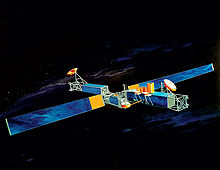Milstar
Milstar (originally an acronym for English Military Strategic and Tactical Relay [ satellite ] , but is now used independently) is a satellite communication system of the United States of America . It enables secure, bandwidth-stable , worldwide communications and is used to secure them in times of crisis and war. It was developed for the requirements of the US military.
properties
Manufactured by Lockheed Martin Missiles & Systems for $ 800 million per satellite, Milstar was the US military's most advanced telecommunications satellite system in 2006. It is a joint service system of the US Army, US Navy and US Air Force. The operational Milstar satellite constellation consists of five satellites that have been positioned in a geostationary orbit around the earth. Each satellite weighs around 4.5 tons and has a guaranteed lifespan of ten years.
Each Milstar satellite serves as an intelligent switch in space by creating direct connections from port to port on earth. Since the satellite truly processes the communication signal and can cross-link with other Milstar satellites, the requirements for ground control are significantly reduced. The satellite establishes, maintains, reconfigures and terminates required communications links requested by users. Milstar connections offer encrypted voice, data, teletype or facsimile communications. A key goal of Milstar is to make interoperable communications available to users of the United States Armed Forces .
Geographically dispersed mobile and locally fixed control stations ensure the vital and permanent operational command and control for the Milstar system.
Satellite launches
The first Milstar satellite was launched into orbit on February 7, 1994 aboard a Titan IV rocket. The second was launched on November 5, 1995 . The four satellites of the second block have a significantly increased capacity due to an additional average data rate. The third launch on April 30, 1999 put the satellite in an unusable orbit. Further successful launches took place on February 27, 2001 , January 15, 2002 and April 8, 2003 .
| satellite | date | Starting place | Launcher | comment |
|---|---|---|---|---|
| Block 1 | ||||
| Milstar 1-1 (Milstar 1, USA 99) | February 7, 1994 | CCAFS | Titan-4A Centaur | |
| Milstar 1–2 (Milstar 2, USA 115) | November 6, 1995 | CCAFS | Titan-4A Centaur | |
| Block 2 | ||||
| Milstar 2-1 (Milstar 3, USA 143) | April 30, 1999 | CCAFS | Titan-4B Centaur | False start, too low orbit |
| Milstar 2-2 (Milstar 4, USA 157) | February 27, 2001 | CCAFS | Titan-4B Centaur | |
| Milstar 2–3 (Milstar 5, USA 164) | January 15, 2002 | CCAFS | Titan-4B Centaur | |
| Milstar 2–4 (Milstar 6, USA 169) | April 8, 2003 | CCAFS | Titan-4B Centaur | |
The " Advanced Extremely High Frequency " system, originally known as Milstar-3 , will be launched in 2008 as the successor system.
Literature / sources
- USAF: Milstar Satellite Communications System (English)
- globalsecurity.org: Milstar-1 (English)
- globalsecurity.org: Milstar-2 (English)
- Satellite world - Geostationary UHF military satellites: MILSTAR

